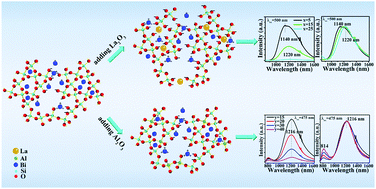当前位置:
X-MOL 学术
›
J. Mater. Chem. C
›
论文详情
Our official English website, www.x-mol.net, welcomes your
feedback! (Note: you will need to create a separate account there.)
Distribution and stabilization of bismuth NIR centers in Bi-doped aluminosilicate laser glasses by managing glass network structure
Journal of Materials Chemistry C ( IF 5.7 ) Pub Date : 2018-06-22 00:00:00 , DOI: 10.1039/c8tc01042k Xiaoman Li 1, 2, 3, 4, 5 , Mingying Peng 1, 2, 3, 4, 5 , Jiangkun Cao 1, 2, 3, 4, 5 , Zhongmin Yang 1, 2, 3, 4, 5 , Shanhui Xu 1, 2, 3, 4, 5
Journal of Materials Chemistry C ( IF 5.7 ) Pub Date : 2018-06-22 00:00:00 , DOI: 10.1039/c8tc01042k Xiaoman Li 1, 2, 3, 4, 5 , Mingying Peng 1, 2, 3, 4, 5 , Jiangkun Cao 1, 2, 3, 4, 5 , Zhongmin Yang 1, 2, 3, 4, 5 , Shanhui Xu 1, 2, 3, 4, 5
Affiliation

|
Due to their super broadband near-infrared (NIR) emissions covering the low-loss window of silica, which rare earth ions cannot effectively cover, bismuth (Bi)-doped glasses have aroused increasing interest for developing a new generation of fiber lasers and optical amplifiers. However, there is no strategy to stabilize Bi NIR emission centers (BNECs) as far as we know. Herein, we propose a local excess charge model to stabilize or destabilize these centers within the glass network; this is verified by a model glass system of La2O3–Al2O3–SiO2 by properly managing the glass structure. Statistical excess charge field around Bi can be built up by either introduction of glass modifier or substitution of silicon by different glass former ions with a valence state not equal to +4 in silicate glass. Addition of glass modifier La3+, as revealed by 27Al MAS NMR, 29Si MAS NMR, and FT-IR spectra, breaks down Si–O–Si bonds and creates non-bridging oxygens (NBOs). The content of NBOs increases as La3+ concentration increases, and the excess negative charges are therefore produced, forcing the conversion of the valence state of partial Bi to a higher valence state for electroneutrality. As a result, the content of BNECs decreases, according to the absorption spectra; meanwhile, the NIR emission shifts to 1220 from 1140 nm along with a monotonous reduction in lifetime. This is perhaps due to the enhanced asymmetric stretching vibration of Si–O− and consequently the enhanced crystal field around Bi as well as the rearrangement of glass network and redistribution of Bi within it after breakdown of Si–O–Si bonds. Substitution of Al3+ for Si4+ can produce similar excess negative charges in the neighbourhood of Bi but in a way completely different from the introduction of La3+. Slight changes in the glass structure are observed, as proved by 27Al and 29Si MAS NMR and FT-IR spectra and in turn, the peak wavelength and lifetime of Bi emission show almost no changes although the emission intensity decreases as Al3+ content increases due to the decreasing content of BNECs. This study solves the problem of stabilizing BNECs in glasses, and it can be helpful for designing Bi-doped laser glasses with stable luminescent properties and for the fabrication of fibers in future.
中文翻译:

通过管理玻璃网络结构,铋掺杂近红外铋在铋掺杂硅铝酸盐激光玻璃中的分布和稳定性
由于它们的超宽带近红外(NIR)辐射覆盖了二氧化硅的低损耗窗口,而稀土离子无法有效地覆盖该窗口,因此掺铋(Bi)的玻璃引起了人们对开发新一代光纤激光器和光学器件的兴趣日益浓厚放大器。但是,据我们所知,目前还没有稳定Bi NIR发射中心(BNEC)的策略。本文中,我们提出了一种局部超额收费模型,以稳定或破坏玻璃网络中的这些中心。La 2 O 3 –Al 2 O 3 –SiO 2模型玻璃系统对此进行了验证。通过适当地管理玻璃结构。Bi周围的统计过量电荷场可以通过引入玻璃改性剂或用硅酸盐玻璃中价态不等于+4的不同玻璃形成离子取代硅来建立。如27 Al MAS NMR,29 Si MAS NMR和FT-IR光谱所揭示的,添加玻璃改性剂La 3+会破坏Si–O–Si键并产生非桥连氧(NBOs)。NBO的含量随着La 3+的增加而增加浓度增加,并且因此产生过量的负电荷,从而迫使部分Bi的价态转换为电子中性的更高价态。结果,根据吸收光谱,BNEC的含量降低了。同时,随着寿命的单调减少,NIR发射从1140 nm转移到1220。这可能是由于Si–O –的不对称拉伸振动增强,因此Bi附近的晶体场增强,以及在Si–O–Si键断裂后Bi的玻璃网络重排和Bi在其中的重新分布。用Al 3+代替Si 4+可以在Bi附近产生类似的过量负电荷,但其方式与引入La 3+完全不同。通过27 Al和29 Si MAS NMR和FT-IR光谱证明,观察到玻璃结构有轻微变化,并且尽管发射强度随Al 3+含量的降低而降低,Bi发射的峰值波长和寿命几乎没有变化。由于BNEC含量的减少而增加。这项研究解决了稳定玻璃中BNEC的问题,对设计具有稳定发光性能的掺Bi激光玻璃以及将来的纤维制造将有帮助。
更新日期:2018-06-22
中文翻译:

通过管理玻璃网络结构,铋掺杂近红外铋在铋掺杂硅铝酸盐激光玻璃中的分布和稳定性
由于它们的超宽带近红外(NIR)辐射覆盖了二氧化硅的低损耗窗口,而稀土离子无法有效地覆盖该窗口,因此掺铋(Bi)的玻璃引起了人们对开发新一代光纤激光器和光学器件的兴趣日益浓厚放大器。但是,据我们所知,目前还没有稳定Bi NIR发射中心(BNEC)的策略。本文中,我们提出了一种局部超额收费模型,以稳定或破坏玻璃网络中的这些中心。La 2 O 3 –Al 2 O 3 –SiO 2模型玻璃系统对此进行了验证。通过适当地管理玻璃结构。Bi周围的统计过量电荷场可以通过引入玻璃改性剂或用硅酸盐玻璃中价态不等于+4的不同玻璃形成离子取代硅来建立。如27 Al MAS NMR,29 Si MAS NMR和FT-IR光谱所揭示的,添加玻璃改性剂La 3+会破坏Si–O–Si键并产生非桥连氧(NBOs)。NBO的含量随着La 3+的增加而增加浓度增加,并且因此产生过量的负电荷,从而迫使部分Bi的价态转换为电子中性的更高价态。结果,根据吸收光谱,BNEC的含量降低了。同时,随着寿命的单调减少,NIR发射从1140 nm转移到1220。这可能是由于Si–O –的不对称拉伸振动增强,因此Bi附近的晶体场增强,以及在Si–O–Si键断裂后Bi的玻璃网络重排和Bi在其中的重新分布。用Al 3+代替Si 4+可以在Bi附近产生类似的过量负电荷,但其方式与引入La 3+完全不同。通过27 Al和29 Si MAS NMR和FT-IR光谱证明,观察到玻璃结构有轻微变化,并且尽管发射强度随Al 3+含量的降低而降低,Bi发射的峰值波长和寿命几乎没有变化。由于BNEC含量的减少而增加。这项研究解决了稳定玻璃中BNEC的问题,对设计具有稳定发光性能的掺Bi激光玻璃以及将来的纤维制造将有帮助。











































 京公网安备 11010802027423号
京公网安备 11010802027423号